
This article was updated on October 21st, 2023
Flea allergy dermatitis (FAD) is an immune response from flea saliva. It occurs when a flea bites and injects an antigen into your dog’s skin. This antigen causes extreme itching, and that itching turns into flea allergy dermatitis or flea scabs. In this article, we will review pictures of flea allergy dermatitis, and explain how to recognize, treat, and prevent this skin condition.
Pictures of flea allergy dermatitis & flea scabs on dogs
Flea allergy dermatitis often results in the following symptoms:
1. Hair Loss (Alopecia)
Hair loss is a sign that your dog has been suffering from a flea allergy for too long. It happens when your dog licks, chews, and scratches excessively. A dog with hair loss needs flea medication and may also benefit from steroid medication, antibiotics, and medicated baths. Pictured below is flea allergy dermatitis with hairloss.

2. Red bumpy skin
Flea allergy dermatitis can cause red bumps on the legs, inner thighs, stomach, lower back, neck, and ears. Bumps from FAD tend to be very itchy and they can become red and crusty when scratched. Dogs with these bumps may need a steroid to control itching, however, they usually do well with a monthly flea preventative.
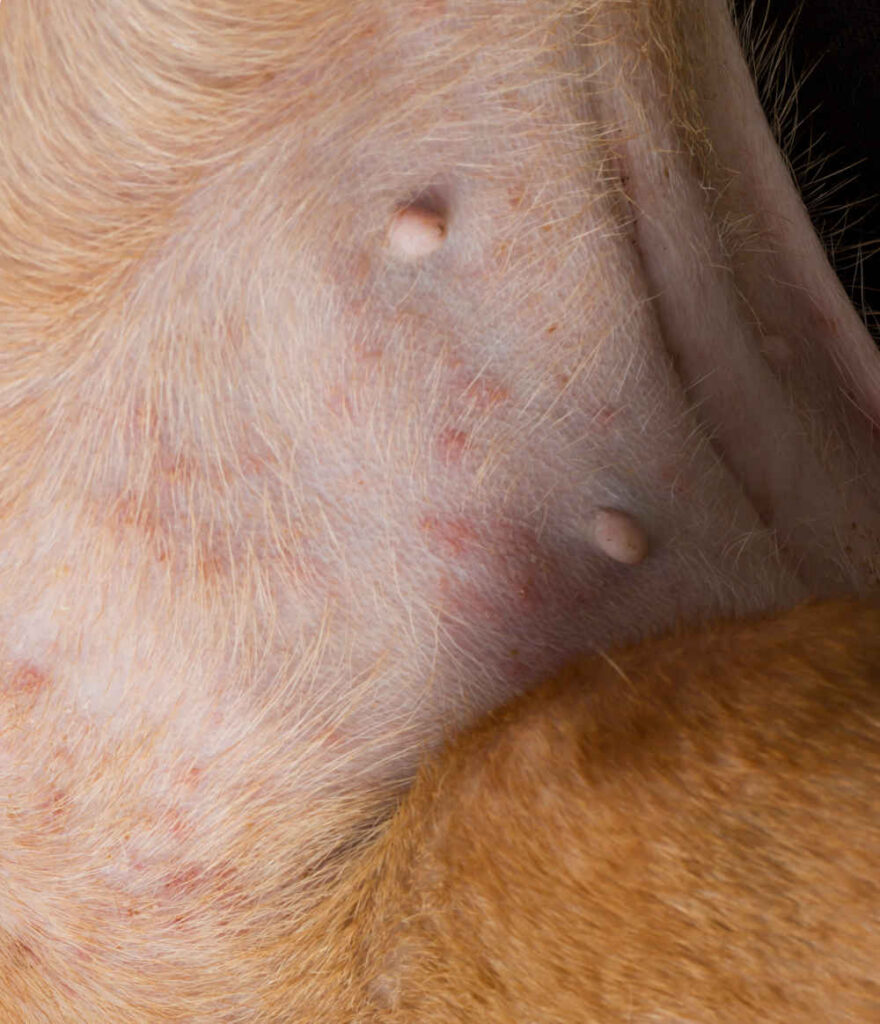
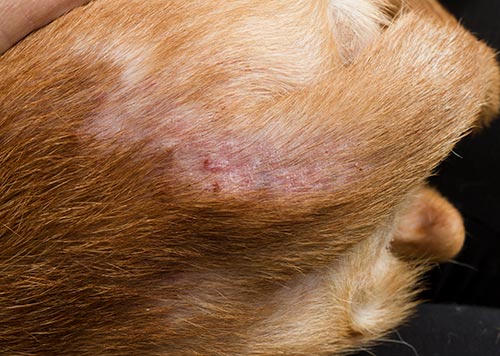
3. Scabs
Scabs are a common symptom of flea allergy dermatitis. Flea scabs can be found on the legs, inner thighs, stomach, lower-back, neck and ears of affected dogs. Dogs with heavy scabbing may need steroid medication, antibiotics, and medicated baths.
Below are pictures of dog skin scabs after flea bites. Dogs with fleas will typically excessively lick, scratch or even have scabs or hot spots.
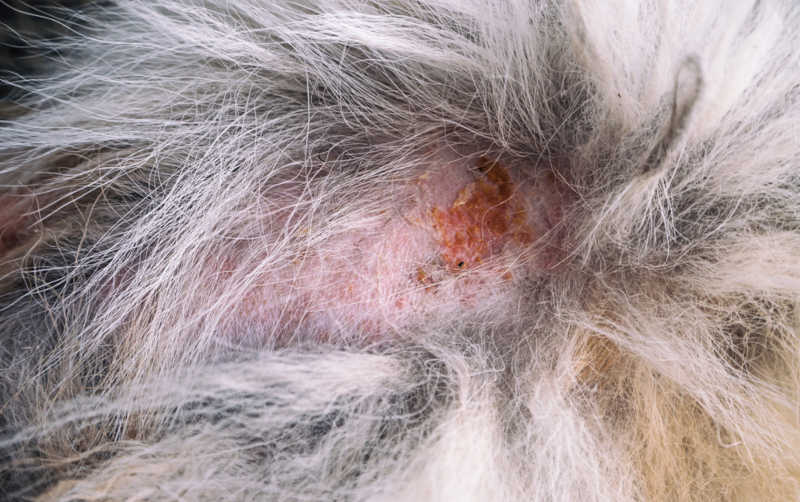
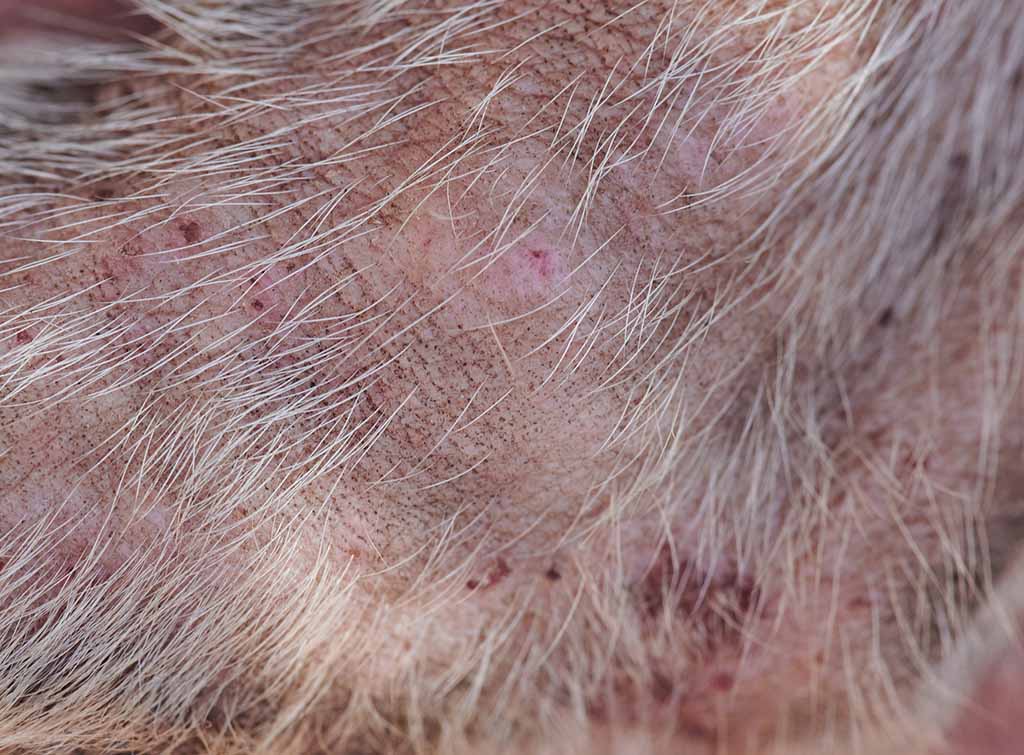
A flea allergy can result in scabs along with hair loss and red skin, as shown on the pictures below. Most dogs tend to be affected over their rump.
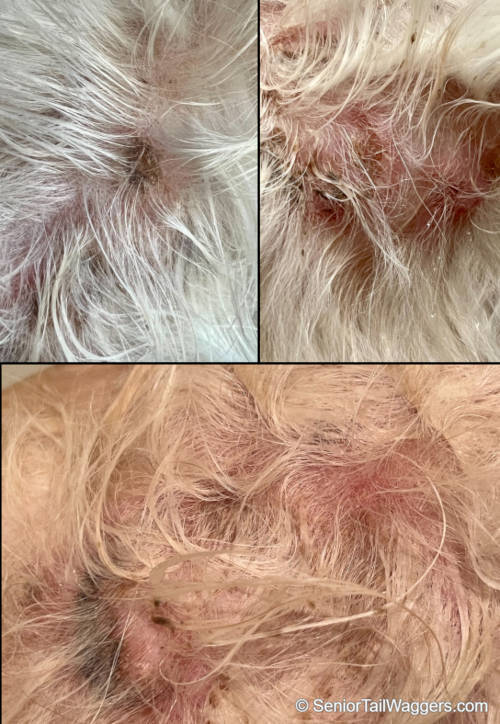
4. Flea poop (Flea excrement)
Flea dirt (poop) can be found on dogs with flea allergies. It looks like little brown-black specks, as shown on the pictures below. You can test your dog for flea poop by using a flea comb such as this one or by parting the hair on his mid-back and collecting some specks with a wet paper towel. If the specks are flea poop they will turn red (like blood) when rubbed on the paper towel.
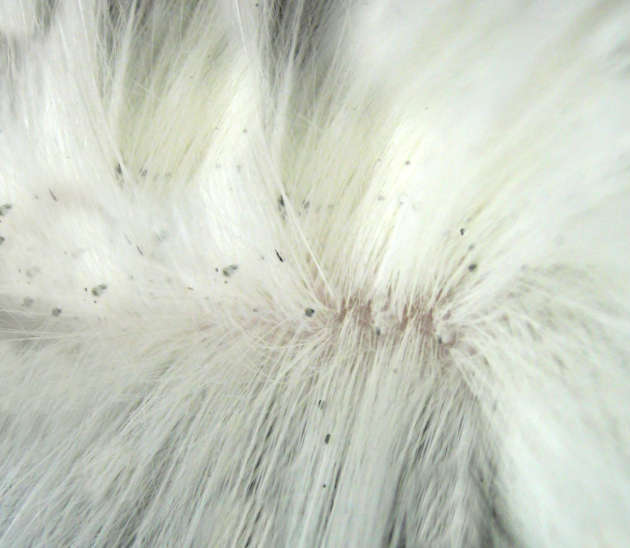
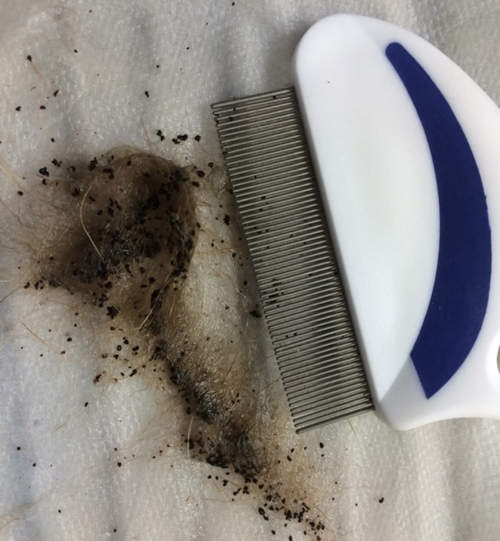
5. Fleas
Fleas are not always visible and most dogs with a flea allergy will groom tirelessly. Self-grooming limits the amount of live fleas we can see, so it’s important to check your dog for fleas. You can do this with a flea comb. A flea comb has tiny teeth that can trap fleas when run through your dog’s fur. To check your dog, part the hair on his lower back and comb through it. If your lucky you might be able to catch a few of the little stinkers.

6. Inflamed skin (Pruritis)
Red and inflamed skin is a common symptom of flea allergy dermatitis. It is most common in dogs who are very sensitive to flea bites and occurs on the legs, inner thighs, stomach, lower back, neck, and ears. If your dog’s skin is red and inflamed he is suffering from a severe allergic reaction. These dogs do best with strict flea control and steroid medication.
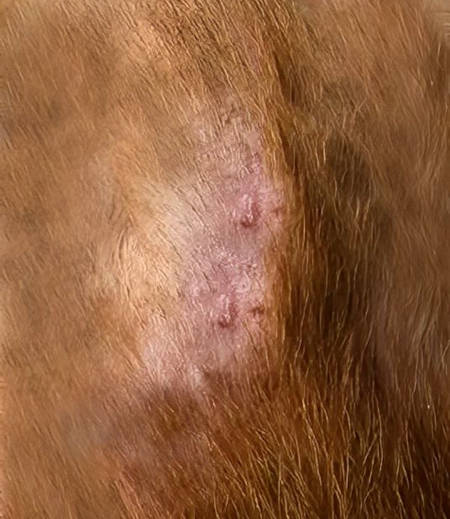
7. Hot Spots (Moist Dermatitis)
Flea allergy dermatitis in dogs can lead to hot spots when the dog excessively scratches and bites at the itchy areas caused by flea bites, creating open sores and inflammation. Hot spots are very painful, but they can be treated with flea medication, steroid medication, and possibly antibiotics.
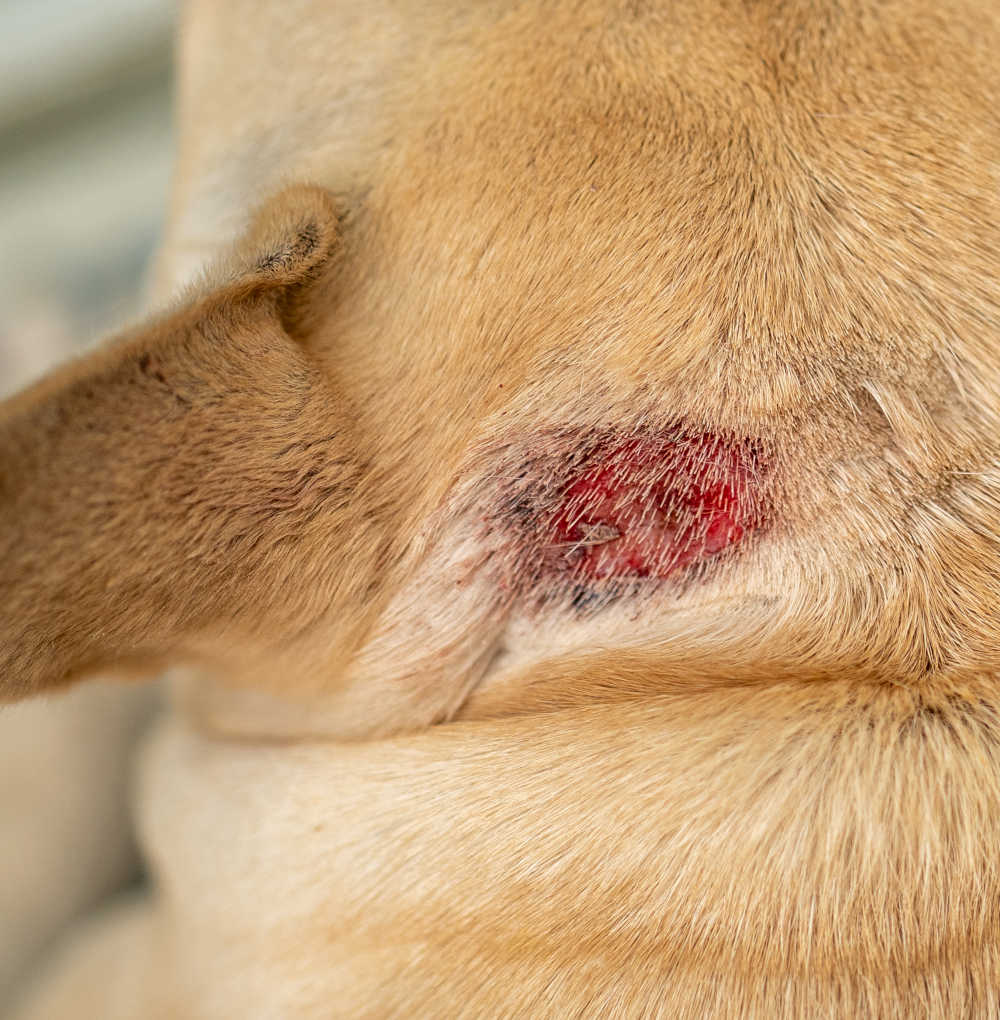
8. Hyper-pigmentation (Acanthosis Nigricans)
Dogs with long-term flea allergies may develop skin hyper-pigmentation (darkening of the skin). Hyper-pigmentation appears on areas that have been licked or scratched excessively. The treatment for skin darkening caused by flea allergies is strict flea control. The darkening is caused by excessive friction from licking and chewing.
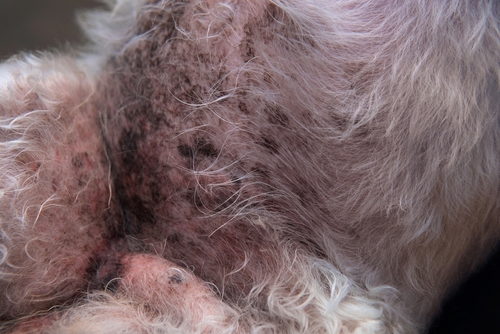
With regular application of flea control, skin darkening will naturally decrease over time. You can see a good example on PetCoach.co here (Hyper-pigmentation on the chest of a terrier with flea allergy dermatitis).
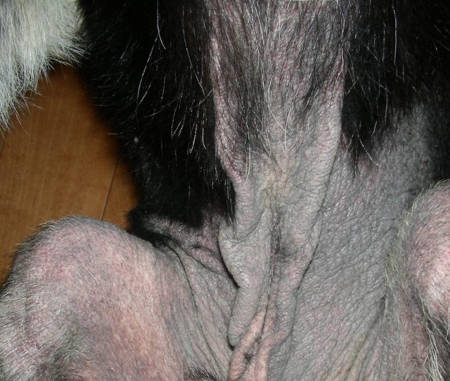
Photo: © Ian Spiegel VMD, MHS, DACVD
Dogs suffering from flea allergy dermatitis tend to scratch, chew, or lick themselves excessively
Flea allergy dermatitis is very uncomfortable, dogs with this type of dermatitis are sensitive and painful. Typical behaviors of dogs with flea allergy dermatitis include:
- Scratching
- Shaking
- Chewing
- Licking
- Nibbling
- Restlessness
Treatment for flea allergy dermatitis
Treatment for flea allergy dermatitis consists of immaculate flea control, antibiotics for secondary infections, and anti-inflammatories. The goal is to eliminate fleas because they are the cause of the irritation. Once the fleas are under control, symptoms usually improve. In fact, according to the Merck veterinary manual, the number one cause of FAD is “infrequent flea product application”.
Over-the-counter flea preventatives are available but are often ineffective and can be unsafe. Flea collars tend to rid the dog of fleas on their neck but not in other areas. Reactions are also common with these over-the-counter collars. Ask your veterinarian which flea preventative is best for your dog.
Flea control:
First things first, if you want to get rid of those fleas, you have to get your dog on a long-term flea treatment. You’ll want to make sure you get your flea medication from a veterinarian. Stray away from flea products sold at retail or pet supply stores. While they may be more affordable, they can also be dangerous and ineffective. Your veterinarian can offer you the safest, most effective flea medication. So what are your options?
The best flea control for your dog depends on your lifestyle, the severity of the infestation, your budget, and your pet’s health. You can choose a topical liquid, an oral pill, or a collar.
Liquid treatments:
Last 1-3 months and are applied at the base of your dog’s head. To apply part the hair at the base of your dog’s neck and squeeze. Be sure to apply slowly and in a line toward your dog’s tail. If you apply it too fast it may drip off. Topical products are very effective. They absorb into your dogs skin quickly and they often protect against other parasites.
Pill, tablet, or chew treatments:
Pill treatments last 1-3 months and are given by mouth ( with a meal). When given with food the medication absorbs better by your dogs stomach. Pills and chews are great for families with children because they don’t leave residue behind.
Flea Collars:
Collars are secured around your dogs neck and they can last up to 8 months. They need to be fit properly to get the best benefits. A collar should be tight enough that it has contact with your dogs skin, but not so tight that it is uncomfortable. They can be tricky and won’t work unless there is collar to skin contact. They work best for small dogs.
With all these options your probably wondering which flea medication works the best. According to research the most effective flea treatments contain one or more of the following active ingredients:
- Afoxolaner (Nexguard) Oral
- Fluralaner (Bravecto) Oral and Topical
- Lotilaner (Credelio) Oral
- Sarolaner (Simparica) Topical
- Selamectin (Revolt) Topical
- Spinosad (Comfortis) Oral
Your vet will choose a flea medication depending on your pets:
- Age (Some dogs, like puppies, will be too young for certain flea products)
- Weight (Your dog’s weight determines the dose.)
- Overall health (Dogs with health problems that can be negatively affected by flea medications.)
- Behavior (Every dog is different, some dogs do well with taking pills, and others do better with topical products.)
Your vet will also consider:
- Your lifestyle (If you spend a lot of time outdoors, your vet can prescribe a product that kills fleas and other pests or parasites.)
- Your family (Owners with small children often prefer a flea pill or collar over a topical.) Topical flea products take a while to dry and can be toxic to children.)
- Whether you have other pets in the household. (All pets that are susceptible to fleas need treatment.)
Treat your house for fleas:
Treating your dog for fleas is only part of the battle. You’ll also need to get rid of eggs, larvae, or pupae lying around your house. You can do this by vacuuming your house and washing blankets and rugs. Make sure you pay special attention to cracks in sofas and chairs. Flea eggs, larvae, and pupae tend to fall into cracks and crevices, so don’t forget cracks in hardwood floors and baseboards. You can also spray an indoor flea treatment. According to research, the best indoor flea treatments include the active ingredients methoprene and pyriproxyfen. These come on both pump sprayers and foggers.
But remember, flea treatments won’t kill fleas right away. According to research, fleas can live and bite your dog 6-24 hours after treatment. So even after you start treatment, you can see fleas in your home for up to 8 weeks.
Flea proof your yard:
Luckily, modern flea treatments are very effective and they eliminate most fleas within a few months without treatment of the environment. However, sometimes flea infestations get so out of control that you’ll need to treat your yard. In this case, you should spray an insecticide in your yard, focusing on shaded areas like dog houses, garages, porches, and animal lounging areas. According to the merck veterinary manual, the best outdoor flea treatments contain the active ingredients imidacloprid, fenvalerate, and cyfluthrin. In the case of a severe flea infestation, you may have to spray your yard twice. Once at the beginning of treatment and again after 7-10 days.
Prevent licking and chewing:
Flea allergy dermatitis gets worse with licking and chewing. To prevent your dog from chewing himself raw, you can put an e-collar (Elizabethan collar) on him. You can purchase an e-collar at your local pet supply store. E-collars prevent your dog from being able to reach irritated areas, which speeds up healing.
Medications:
It is not uncommon for dogs with FAD to develop a bacterial infection or severe inflammation of the skin. In these cases veterinarians recommend one or more of the following medications:
- Steroids (to reduce inflammation and pain)
- Antibiotics (to fight infection)
- Medicated shampoos, creams, gels, ointments, or mousses (to fight infection)
How long does it take to get rid of flea allergy dermatitis?
FAD will begin to improve as soon as you start flea treatment. With strict flea control, fleas will be gone in 1-3 months. But remember, fleas can replicate fast. One adult flea can lay 50 eggs in one day. It only takes one skipped dose to cause another episode of flea allergy dermatitis. So please, keep up with regular flea control.
When should I call my veterinarian?
If your dog has FAD, you should seek treatment immediately. Dogs with untreated flea allergies can develop skin infections and anemia (low red blood cell count.)
Your vet can diagnose the problem, prescribe medication, and get your pup comfortable quickly. However, if your dog shows any of the following symptoms, they could have flea-induced anemia, and you should take them to the vet immediately:
- Weight loss
- Heavy breathing
- Loss of appetite
- Bloody nose
- Blood in urine
- Blood in vomit
- Pale gums
- Weakness
- Lethargy
Is Flea Allergy Dermatitis common in dogs?
In general, FAD is a common condition in dogs. In my practice, we see it daily, and while it is most common during the summer, it can occur any time temperatures are ideal for flea breeding. FAD is a preventable disease. The way to prevent it is by treating your pets for fleas regularly. If you are strict with flea control, flea allergies will likely never be a problem for your dog. Nine times out of ten, dogs with FAD are NOT on a monthly flea preventative.
Disclaimer: This website's content is not a substitute for veterinary care. Always consult with your veterinarian for healthcare decisions. Read More.

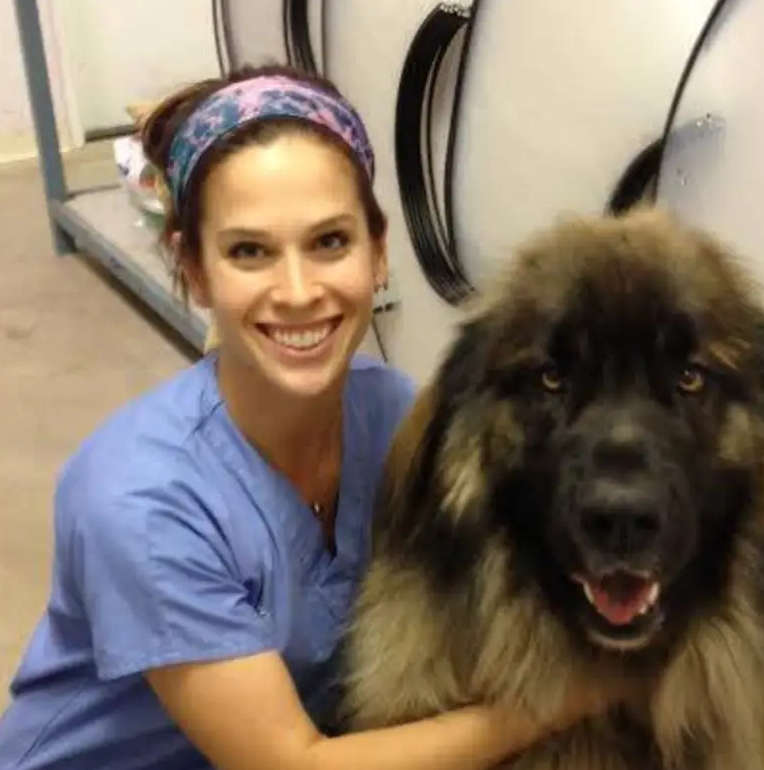
Be the first to comment